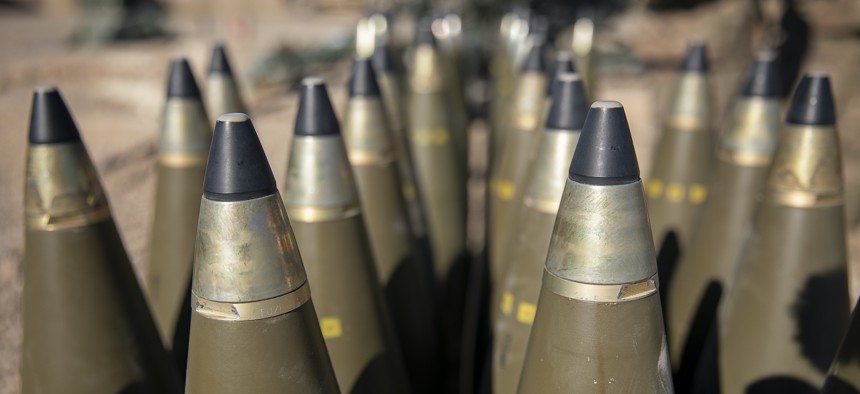
155mm howitzer rounds. U.S. Army / Spc. Derek Mustard
US to Train Ukrainians to Use Their New 155mm Howitzers
The donated artillery is expected to arrive within days—but there are reports that the Russian assault in the east is already starting.
U.S. troops will train Ukrainian counterparts to use the artillery pieces headed their way against Russian forces gathering in Ukraine’s Donbas region, defense officials said Monday—just hours before Ukrainian officials reported intense shelling ahead of an expected new assault.
“We believe we're going to be able to start this training in the next several days. It'll be just the initial efforts. There may be additional ones in other places and at other times,” a senior defense official told reporters.
The U.S. is sending eighteen 155mm towed howitzers and 40,000 artillery rounds drawn from domestic U.S. Army and Marine Corps units as part of the recent $800 million security assistance package for Ukraine. Four flights with other equipment from the package arrived in the region Sunday and another is expected within a day. The artillery and ammunition are expected to head out soon.
“Artillery is a specific item that the Ukrainians asked for because of the fighting that they expect is going to occur in the Donbas,” Pentagon spokesman John Kirby told reporters Monday. “The terrain lends itself to the use of artillery, to long-range fires as we call it. And we know that the Russians also believe the same thing, because we're seeing them move artillery units into the Donbas as well. And so we want to give the Ukrainians every bit of advantage that we can.”
The “train the trainer” work will take place outside Ukraine with a small number of Ukrainian troops, according to Kirby, who would not give the location. The troops will then return to Ukraine to train their colleagues.
The Pentagon expects the Ukrainian trainers to quickly learn to use the American artillery pieces, Kirby said.
“The Ukrainians typically use 152mm. It's a different caliber but it doesn't mean that it's going to be overly laborious to get them up to speed on this. And I think, again, we'll be able to get this training done, at least the first round of it, in the next several days,” he said.
U.S. troops have routinely trained Ukrainians in Ukraine since Russia seized Crimea in 2014. But the Pentagon withdrew its forces—elements of the Florida National Guard—just before Russia’s larger invasion began on Feb. 24.
Earlier this month, Defense Secretary Lloyd Austin told lawmakers that U.S. troops were training Ukrainians outside the country on to use some of the gear being sent to them.
The new U.S. equipment is heading to Ukraine as Russian forces continue to concentrate their ground forces in Ukraine’s east and the south and set up conditions for future operations. They have sent 11 additional battalion tactical groups to Ukraine over the past few days, the senior defense official said. The Pentagon also believes that about 22 Russian battalion tactical groups north of Ukraine are going through some form of refitting and resupply.
In the Donbas region, where Ukrainian troops have been fighting Russian-backed separatists for several years, Russia is “moving in heavy artillery, they're moving in command-and-control enablers, they’re moving in aviation, particularly rotary aviation support,” the senior defense official said. “It appears as if they are trying to learn from the failed lessons of the north, where they didn’t have proper sustainment capabilities in the area they were about to operate.”
The Russians still have “significant challenges” with command and control, logistics and sustainment, Kirby said. Whether they will learn from their past mistakes is still to be seen.
“They're conducting themselves in ways that we didn't see them around Kyiv, for instance. So it appears as if they're trying to learn. Now whether they will be successful in doing that, whether we can say they have learned, I just don't think it's—we're ready to say that right now. I think it’s too soon to know,” he said.




